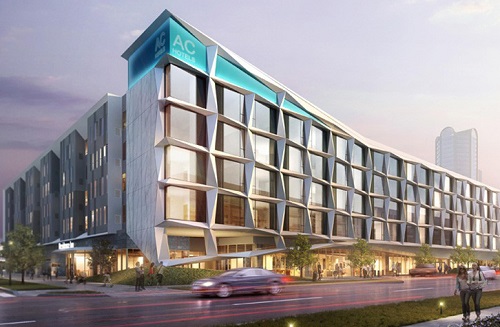

Hotel developers are working to offset the rising cost of construction labor, driven by the latest post-recession building boom. Sources said that while prices for raw materials have seen relatively stable growth in recent years, a shortage of skilled labor in many markets has caused wages to surge at far more aggressive rates.
Much of what’s lurking behind the current trend comes down to sheer supply and demand: Since the 2009 recession, construction activity nationwide has resumed, creating increased need for labor. So much need, in fact, that sometimes there aren’t enough workers to go around. In those cases especially, hiring a work crew can cost dearly.
“The cost of labor is directly proportionate to the demand, generally speaking, in construction. When the economy’s better, when construction’s going up, all around the country the cost of labor goes up,” said Navin Shah, chairman of Royal Hotel Investments, which will open a new Holiday Inn Express in May in Conyers, Georgia. “Right now, what’s happening is good subcontractors are hard to find.”
•More on development: "What Trump's trade policies could mean for FF&E"
It’s not just hotel construction that’s gobbling up the labor pool. On a market-by-market basis, there might be other extraordinary factors, like large municipal or corporate projects underway or seasonal conditions, affecting the supply of workers. Some cities have reportedly been squeezed harder than others.
“We had a couple of properties that were hit hard from the hurricane in Florida, and they had to be restored at several million dollars each. There was at least a 10% to 12% escalation there because of the storm,” said Paul Breslin, managing director of Horwath HTL. “In Atlanta we’re working on projects and there’s probably a 15% escalation because of the two stadiums being built there. Anything in the South Sun Belt has been affected because of the lack of workers; it’s really escalated the payroll. They’re paying more for the jobs and that’s causing some challenges in payroll.”
Others owners said they’ve recently seen labor costs increase as much as 25% to 30%. When factoring in the inevitable rise in material costs, the need to cut costs where possible becomes tantamount. One solution, according to sources, is hiring the right talent to lead the project and then making smart, strategic choices from there.
“We like to bring in a strong general contractor from day one, and a strong architect, and sit down with them and get some kind of guidance on what our square-foot cost is going to be, and put a little bit of contingency in there,” said Perry Molubhoy, CEO of Atlantic Hotels Group. “Then we’ll keep working on the drawings with the GC’s input, so every time an iteration is ready by the architect, it’s put out to the GC for their review, and if they see certain things that are alarming, they will suggest the architect or engineers go back and revisit. In one of our projects, that by itself saved us a couple of million dollars in structural costs.”
Atlantic just opened the upscale dual-branded Aloft and Element Dallas Love Field and plans to open four more hotels in 2017, followed by another dual-branded property in 2018 (an AC and Residence Inn by Marriott in Dallas).
Molubhoy said that his company’s smart-hire strategy is also essential when it comes to enlisting engineers, whose decisions can mean the difference of millions in development costs. He added it’s critical to be utterly confident in that professional contractor. In many cases, you get what you pay for.
“Some of the structural engineers and civil engineers will overdesign your project,” Molubhoy said. “Sometimes you can find inexpensive engineers who can really turn it around much faster at very economical pricing, but sometimes they’re over-engineering it, so just be careful to hire the right engineers. They may be expensive upfront, but someone can save millions of dollars in the field when they’re developing these hotels because they’re optimally engineered instead of over-engineered.”
Finding balance in cost savings
Some hotel owners are looking to advances such as innovative computer design technology, next-generation pre-fabricated rooms and even shifting brand standards as cost-cutting contributors. On the branding side, a dialogue is underway concerning what features are truly necessary in a modern guestroom, which aspects are possibly expendable holdovers from the past and what might be saved—in both dollars and square footage—by reconsidering the current norms.
“The millennials are getting us to rethink things; they’re OK with smaller rooms,” Breslin said. “The brands are also helping. They’re really taking a very aggressive progressive approach to not just driving brand standards, but trying to show you ways to save money. Like, ‘Don’t build extra storage you don’t need; build pods at the front desk instead of those old-fashioned front desks; put smaller FF&E in the guestrooms…’ They’re doing a lot of things to help offset the cost.”
And with the larger spaces that do get built, developers said maximizing the revenue potential per square foot is a main priority. Considering the upward trend in construction costs, which are expected to only keep increasing, it is now more important than ever to be sure that virtually every inch of a property—particularly public spaces—offers some form of cost-balancing potential.
“If you have a lot of square footage, you’re going to have a lot of costs,” Breslin said. “If you can turn your square footage into something revenue-producing—like the Marriott great room, where the lobby turns into a bar—it’s actually an old-school thought. If you look back at the hotels of the ’40s and ’50s, that’s what they did: You had coffee in the morning in lobbies and then it became the lobby bar. That’s come back, and now it’s revenue-producing. You’re not just buying a couch for somebody to sit there; it’s designed for food and beverage.”
Copyright 2006-2025 Shanghai Sinoexpo Informa Markets International Exhibition Co., Ltd. All rights reserved